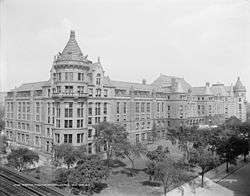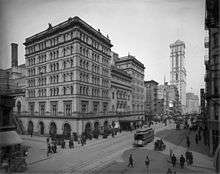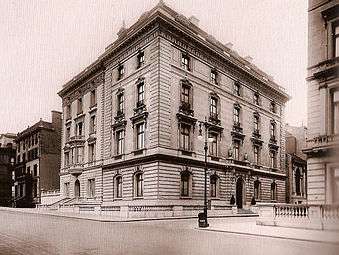J. Cleaveland Cady
| Josiah Cleaveland Cady | |
|---|---|
| Born |
1837 Providence, Rhode Island |
| Died |
(aged 82) New York City |
| Occupation | Architect |

Josiah Cleaveland Cady, commonly known as J. Cleaveland Cady (1837 in Providence, Rhode Island – April 17, 1919 in New York City.[1]) He was a New York-based architect whose most familiar surviving building is the south range of the American Museum of Natural History on New York's Upper West Side. He worked in partnership from 1870 with Milton See (1854 - October 27, 1920) and from 1873 with Louis DeCoppet Berg (1856-1913) in the firm of Cady, Berg & See. The firm was dissolved in 1909.
Cady was the son of Josiah Cady and his wife Lydia, of Providence, Rhode Island, where he was born. He graduated from Trinity College, Hartford, Connecticut, in 1860; the following year he married Emma M. Bulkeley, of Orange, New Jersey; they had five children.[2] Cady was a devoted Presbyterian, who served as head of the Sunday school at the Presbyterian Church of the Covenant, East 42nd Street; his first church commission was the First Presbyterian Church of Oyster Bay, New York. Here he utilized the Carpenter Gothic or Stick Style to create a surprising effect for this wood-frame church building set on a hillside overlooking Oyster Bay.
Cady, Berg & See

Cady was the architect of the original Metropolitan Opera House, opened October 1883 (demolished in 1967). Suitable to the Italian opera that was central to the repertory as New Yorkers then conceived it, the new house for the Metropolitan Opera presented a palazzo-like full front on Broadway between 39th and 40th streets that offered three tiers of arched triple openings framed by strong masonry piers. Soon the facade was flanked by matching seven-story towers, to provide extra space and income to support the opera. Cady's original auditorium was gutted by fire on August 27, 1892.
The American Museum of Natural History has a magnificently rusticated Richardsonian Romanesque entrance range by Cady, Berg & See, stretching 707 feet along its 77th Street frontage. The Museum also preserves its Cady auditorium, restored in 2002 as the Samuel J. and Ethel LeFrak Theater.
Cady and See designed the New York-Presbyterian Hospital, the Skin and Cancer Hospital,[3] Bellevue Medical School, and the Hudson Street Hospital, and also many churches.
They designed many college buildings, fifteen buildings for Yale University alone,[4] and buildings for Williams College, Trinity College in Hartford, Connecticut[5] and for Wesleyan University. Cady served as a trustee for Berea College in Berea, Kentucky, during the tenure of President William Goodell Frost, Cady's nephew. He designed many of the buildings on the Berea College Campus.
At Trinity College, Cady's 1878 St. Anthony Hall (Delta Psi)[6] is massively rusticated Richardsonian Romanesque in style, with narrow "arrow-slit" windows and even a tall cylindrical tower with a steep conical roof. The tower is half-embedded within the densely massed picturesque structure.

In 1880, Cady, Berg & See were hired by William West Durant to design a summer chapel on an island in Raquette Lake, New York, to entice his wealthy acquaintances to build their summer homes in the area. The chapel was constructed in the Stick Style. The plans were used in 1881, modified by Durant at the request of Harriet Beecher Stowe, for the Church of Our Saviour in Mandarin, Florida, and again in 1883 for the Church of the Good Shepherd in Beattystown, New Jersey.
Ten years later Cady again built a chapel on Raquette Lake, St. William's Roman Catholic Church on Long Point, again in Shingle Style, for Durant's employees and local residents. Both churches, only accessible by water, preserve and reflect the Adirondack heritage.
Among the firm's New York houses was the Isaac Stern House, 858 Fifth Avenue (demolished).
Cady & Gregory
In 1909, after Cady, Berg & See was dissolved, Cady and William S. Gregory (a long term associate) formed a partnership known as "Cady & Gregory," with offices at 40 West 32nd Street, New York.[7]
Works
Buildings designed by Cady which survive and which are listed on the U.S. National Register of Historic Places include:
- American Museum of Natural History, Central Park West and 77th St., New York, New York (Cady, Berg & See)
- Barron Library, 582 Rahway Ave., Woodbridge, New Jersey (J. Cleveland Cady)
- Boone Tavern Hotel, 100 Main St., Berea, Kentucky (Cady and See)
- Church of the Holy Communion, Summit Ave., Norwood, New Jersey (J. Cleveland Cady)
- Cliffside, Lawrence Ln. S of River Rd., Palisades, New York (J. Cleveland Cady)
- Demarest Railroad Depot, 38 Park St., Demarest Borough, New Jersey (J. Cleveland Cady)
- First Presbyterian Church of Albany, Albany, New York (J. Cleaveland Cady)
- First Presbyterian Church of Oyster Bay, E. Main St., Oyster Bay, New York (J. Cleveland Cady)
- First Romanian-American Congregation Synagogue, 89-93 Rivington St., New York, New York (J.C. Cady & Co.)
- Grace Episcopal Church Complex, 15515 Jamaica Ave., Queens, New York (Cady, Berg & See)
- Othniel C. Marsh House, 360 Prospect St., New Haven, Connecticut (J. Cleveland Cady), a U.S. National Historic Landmark
- One or more properties in Plantsville Historic District, Roughly bounded by Prospect St., Summer St., Quinnipiac River, Grove St., S. Main St., W. Main St., and West St., Southington, Connecticut (Josiah Cleveland Cady)
- Saint Anthony Hall, 340 Summit St., Hartford, Connecticut (Josiah Cleveland Cady)
- St. William's Catholic Church, Long Point on Raquette Lake, Long Lake, New York(J.C. Cady & Co.)
- One or more properties in Upper Closter-Alpine Historic District, Roughly bounded by Forest St., Old Dock Rd., School House Ln., Church St. and Closter Dock Rd., Alpine, New Jersey (J. Cleveland Cady)
Legacy
Cady presented his architectural library to Trinity College in 1918 and died the following year at his apartment, 214 Riverside Drive.[8] A 1993 Trinity College exhibition "Forgotten architect of the gilded age: Josiah Cleaveland Cady's legacy" with a catalogue by Kathleen A. Curran, failed to cause Cady's reputation to rebound.
Notes
- ↑ New York Times obituary as 'J. Cleveland Cady', 18 April 1919
- ↑ Obituary, New York Times.
- ↑ Dr. Cady was president of the hospital's board of trustees.
- ↑ The Lamson, Fairweather, White, Berkeley and Pearson dormitories, Dwight Hall and the Chittenden Library.
- ↑ Trinity presented him with an honorable L.L.D. in 1905.
- ↑ Cady was a member of the fraternity (Obituary).
- ↑ Obituary.
- ↑ The seven-storey Beaux-Arts style apartment house built in 1900–02 to designs by Stein, Cohen and Roth still stands.(Certificate of Appropriateness, Landmarks Commission).
Sources
- Schuyler, Montgomery. "The Works of Cady, Berg & See." The Architectural Record VI (July 1896-June 1897): pp. 516–553
- Wessels, William. "The Story of the Twin Churches." Utica, New York: Trailmarker, July–August 1962
External links
- Facade of the old Metropolitan Opera
- Victor Katz' photographs of the Trinity College Delta Psi fraternity
- - 1880 Church of the Good Shepherd Raquette Lake, NY
- - 1881 Church of Our Saviour, Mandarin, FL
- - 1882 Beattystown Presbyterian, NJ
- - 1890 St. William's on Long Point, Raquette Lake, NY
- - 1883 First Presbyterian Church, Albany, NY